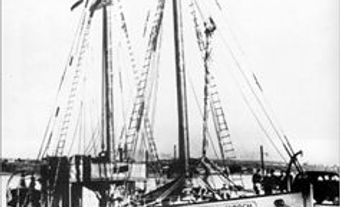Nonsuch was an English ship that traders sailed to Hudson Bay in 1668. Their mission was to explore the bay’s potential as an access point for the fur trade. The success of the voyage led to the creation of the Hudson’s Bay Company and the commercial domain of Rupert’s Land.

Nonsuch set out for Hudson Bay from Gravesend, England, on 3 June 1668. On board were Sieur des Groseilliers and a small crew commanded by Zachariah Gillam. The ship anchored off the mouth of a river the explorers named rivière de Rupert, at the southern tip of James Bay, on 29 September. A second boat, the Eaglet, with Pierre Radisson aboard, was forced to turn back.
The two French traders had persuaded Prince Rupert and a group of English investors to fund the voyage. They hoped to prove that the vast fur resources of interior North America could be tapped via Hudson Bay.
Did you know?
The name Nonsuch means “none such” or “without equal.”
Nonsuch’s crew wintered in James Bay, building a camp on the shore. In the spring, they traded with local Cree for beaver pelts. They then returned to England, landing in October 1669 with a large cargo of furs. The press reported that these furs “made them some [financial] recompense for their cold confinement.” The profitable voyage won the continued support of the investors. As a result, King Charles II granted the charter for the Hudson’s Bay Company (HBC) on 2 May 1670.
In 1968, the HBC ordered a replica of Nonsuch built in Appledore, Devon, England to honour the company’s 300th anniversary. It was shipped to Montreal in 1970 and displayed on the Great Lakes and Pacific Coast for three summers. It was then installed in the new Manitoba Museum in Winnipeg, where it remains a permanent exhibit. The Nonsuch replica is considered one of the most accurate reconstructions of a 17th-century ship.
See also: The Voyage of the Nonsuch: A Turning Point in the Fur Trade; Fur Industry.

 Share on Facebook
Share on Facebook Share on X
Share on X Share by Email
Share by Email Share on Google Classroom
Share on Google Classroom

